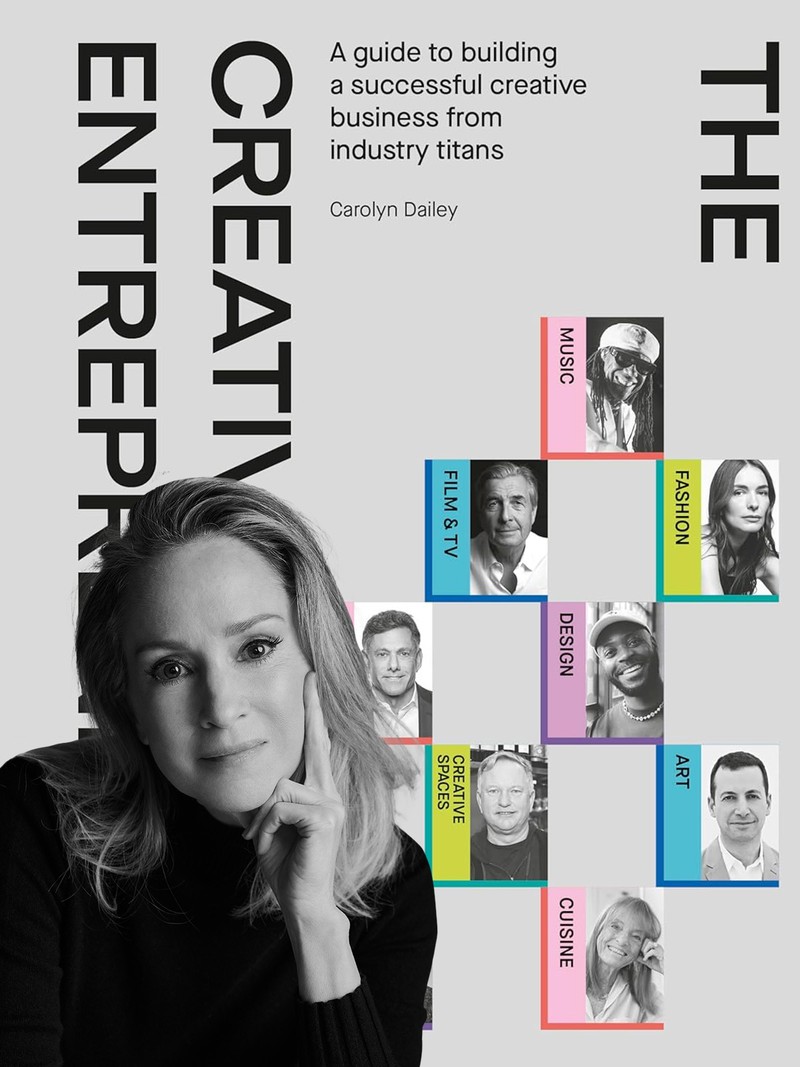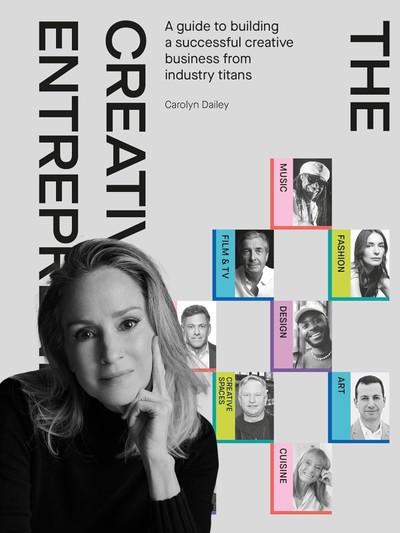

How To Use Creativity For Commercial Success
Let’s start with the people you’ve interviewed in the book – what makes them interesting?
First and foremost, these people are amazing at what they do. What they produce and put into the world is original, imaginative and innovative. I have found time and again that creatives really want to learn and collaborate with other creatives – Roksanda, for example, is very influenced by high art. Each sector might have its own language, but there tend to be universal themes. Hopefully the book helps creative people understand they're part of something bigger. I also thought it was interesting to talk to people at different stages of their businesses and careers. Some are legends, others are perceived as instant successes. Nile Rodgers has defined creativity throughout the decades, for decades, but then I have contributors like Priya Ahluwalia, who are just starting out.
Business and creativity are often seen as opposed – did your research explain why?
The short answer is because there’s such a lack of business support for people in the creative sectors. I’ve spent my whole career in the creative sector – mainly in film and television – and in contrast to friends who are in industries like tech, there isn’t really a system offering to support and nurture creative people and their businesses. And yet the sector is incredibly important economically – plus, it helps us connect emotionally – so why wouldn't there be more support? It’s one of the myths I hope the book dispels – that the creative industries are frivolous and full of flaky, disorganised people. Business empowers creativity, and it’s something to be proud of.
Why else do people struggle to turn a creative venture into a commercial success?
You can have all the creative ideas you want, but unless you have the business side, you can't make them real. The biggest missing piece is role models. Creative people don't see themselves modelled as successful businesspeople, and that’s where the idea for The Creative Entrepreneur came from. Interestingly, I didn’t have to really ‘convince’ anyone to be part of this project – they all felt the same way and wanted to share their insights, knowledge and advice.
Tell us about some of those key insights…
One that immediately springs to mind is that community and network play a huge part in turning creativity into commercial success. The second was understanding your creative vision and your values, including why you're unique, and sticking to that. Don’t get pulled off track. The architect Yinka Ilori told me about a time in his life when he thought he should be doing what the PR people wanted or some gimmick to get a bigger audience. But deep down he knew he had to be clear about who he was and what his unique creative vision was, and stick to that no matter what.
Another common thing I heard is not to necessarily follow a classic template for building a business. The media often glorifies stories about companies that get investors in right away. Then they hire as many people as they can with all that investment and scale quickly before going public. But everyone I spoke to understands that's not the only way to build a business. Some of them don't want investors because they want to stay true to their creative vision. Plus, they know that investors give you money based on a business plan and, once they're in, they're not going to let you change that business plan. They're going to want their money back in three to five years. And yet very few of the people I spoke to are thinking about an exit strategy – this is their life's work.
If they’re not following traditional models, how do creative people build their businesses?
Yinka talks a lot about this, as does Andy Harries from Left Bank Pictures. It's patience, being realistic about timing, talking to as many people as you can, getting help where you need it and understanding how quickly you can go – the whole game is about being able to stay at the table. If you build things too quickly, and you take on new financial responsibilities, you may not be able to sustain it in the long term. A lot of them also said not to bury yourself in work, which was interesting. They emphasised the importance of having a life you're happy with, and that's going to help your creativity – not make you feel like you’re in over your head.
Did any of them say anything that surprised you?
I think there’s a pressure to constantly reinvent, be relevant and at the forefront of things as a creative, but what surprised me was how many of them said they thrive on that. They don’t see it as a challenge – or at least, not a bad one – it’s just part of the deal. They understand that success isn’t a straight line.
Nile Rodgers is a good example. He’s 72 now but first found fame in the 1970s with CHIC, who were the kings of disco. Then there was suddenly this cultural backlash against disco in the US. Nile said the record labels just wouldn't let them produce records anymore. But he said what saved them was a signed contract with Berry Gordy, a famous producer, to work on an album for Diana Ross. Looking back, he said if they hadn't signed that contract, CHIC would not have survived. It ended up being Diana Ross’s biggest album – Diana with ‘I'm Coming Out’ on it. Nile says he’s found most of his success to date as a music producer for people like Madonna, Duran Duran, Daft Punk. And even now, he’s working with Burna Boy and K-pop bands. So that's interesting – what could have been a huge failure forced a massive pivot, and it’s ultimately given him longevity.
A lot of successful people talk about luck and timing – did this ring true in your interviews?
Matthew Slotover, the co-founder of Frieze Art Fair, talks about this. He’s always said he was really lucky to be in London in the late 80s and early 90s, when the hottest things were happening in contemporary art. But really, the key is to engage your talents and your ambitions at the right time. You need to get yourself into a position or on a road towards where your skills and interests are. Then you can capitalise on timing and luck when they align. No one can predict when opportunities will come, but you can put yourself in a position to grab them when they do. You need to have vision and understand what's happening in your industry to be able to take advantage of that timing. You need the ability to sense a zeitgeist.
What about risk – do creative people have a bigger appetite for it?
Definitely – and also a determination to keep going. I wouldn’t say any of them struck me as reckless, but they know how to keep going. When Thomas Heatherwick got out of design school (he didn't study architecture) he wanted to start his practice and found this old button factory in Camden. He used it as his office and lived there to save money. There was a lot he didn’t know how to do – Excel, accounting – but he would find people to help him. His main advice was to stick it out, do what you have to do to make it work, and don’t expect success overnight. Manage things so you can stay at the table. Feel the fear, do it anyway and focus on having a growth mindset, which can sound a bit woo-woo, but visualisation often works.
Is there a common business lesson your interviewees have learnt?
Probably that no one can do it alone. It’s really important to find the right people, which isn’t always easy. You need people who have the skills you’re looking for, but also the loyalty and interest in your joint success. Also, a lot of them don’t see growth in the same terms. Most people think success means scaling your business really fast with tons of investment. But it can be a cautionary tale – investment means giving away control, sometimes majority control. You end up being an employee, not an entrepreneur. A lot of people don't realise that. But it’s difficult because society says if you don't want to go big or go home, you're a loser. It takes someone special, and with a different point of view, to know when to cap their definition of growth and success, and be happy with what they’ve built.
Nick Jones talks about taking Soho House public, and the trials and tribulations of that. Also, Roksanda had a shop in Mount Street but rents were going up all the time, and she's so much happier since she gave it up. You have to do what makes sense for your business, and not think there's a one-size-fits-all answer to how a successful business looks. Something that might look like a failure to someone else might just be a smart decision. You need to know when to cut your losses before it gets worse.
Finally, what do you hope people get from the book?
My hope is that it provides a great map of the overall creative landscape. In between each of the ten interviews, we have some business essentials: ten key topics that creative people need to know about. Readers can look at that and think, ‘Ok, I don't know anything about that. Let me find out more.’ They’ll see where their blind spots are and get a lot more learning on building a brand.
The Creative Entrepreneur: A Guide to Building a Successful Creative Business from Industry Titans is published by DK & available to buy now on AMAZON.CO.UK .
Follow @CAROLYN_DAILEY
DISCLAIMER: We endeavour to always credit the correct original source of every image we use. If you think a credit may be incorrect, please contact us at info@sheerluxe.com.


